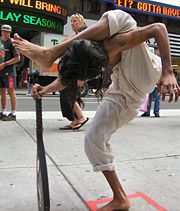
The Ancient Martial Art of Crom-Fu
Learn Martial Arts!
Build Strength, Balance, and Flexibility!
Increase Confidence!
Lose Weight!
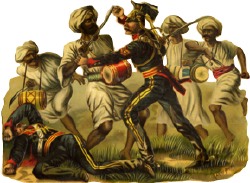
An Imperial English soldier in the Punjab cracks open an extra-large can of Crom-Fu on some hapless natives.
DANGER: This page describes an extremely dangerous form of combat, and should be used for historical reference only. Even the preliminary exercises described below may cause severe injuries or death to the practitioner, and almost certainly to anyone it is practiced upon. Under no circumstances should anyone attempt this training or these fighting techniques. This page cannot be responsible for the inappropriate application of any information it contains.
The Four-Fold Way of Crom-Fu
As described by Oliver Cromwell in his treatise A New & Violent Meanes of Fyghting, the Four-Fold Way of Crom-Fu is:
- Flexibility
- Balance
- Strength
- Aggression
Oliver Cromwell developed Crom-Fu during the years he spent in the Middle East between 1618 and 1623.

Bab Sharqi or the Eastern Gate, the entry into the old city of Damascus where Oliver studied mixed fighting methods.
Little is known of his precise itinerary, but it is known that he spent time in both Damascus and Cairo, as well as with some desert tribes of northern Arabia. It is thought that he might have ventured as far as Baghdad, although hard evidence for this is lacking.
What is definitely accepted by all scholars of that period is that Oliver developed much of the technique of Crom-Fu during this time. The work with edged-weapons, unique to Crom-Fu, is clearly based on Moorish techniques, while the general brawling style is based on that still found to this day in some of the suqs and bazaars of the region.
Both the high-speed blade work and brawl techniques build on the strength training and aggression enhancement undertaken by the dedicated Crom-Fu student. Some scholars believe that some aspects of the brawling techniques later influenced the development of other martial arts such as French Savate (a Gallic form of kick-boxing and open-handed strikes), Portuguese Jogo do Pau (eastern Iberian stick-fighting), Russian Боевое Самбо (based on Uzbeki Kuraş, a form of upright jacket wrestling) and other grappling and open-handed European and Central Asian martial arts.
Amazon
ASIN: B001CZ9JW2
Possible connections between Crom-Fu and more distant and weapon-based martial techniques remain a matter of scholarly debate — these speculative connections are to subcontinental martial art forms such as Silambam (Tamil stick-fighting) and Gatka (Sikh-Punjabi techniques based on sword fighting), and to Eskrima (an entire class of Filipino martial arts blending south-east Asian techniques with European, largely Spanish, martial arts). However, there is little debate of the early exchange of ideas between Crom-Fu and Siamese forms, given the obvious similarity between many classic Crom-Fu moves and specific techniques formerly used in Muay Thai (also known as The Art of the Eight Limbs) until their banning for humanitarian reasons under the rule of King Chulalongkorn the Great.
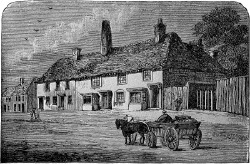
The Dog's Bollocks at left, a Huntingdonshire pub in which Oliver experimented with various combinations of brawling techniques.
Oliver was back in his ancestral home of Huntingdonshire in central England by the winter of 1624.
During the next year he polished his brawling techniques in area pubs and worked long hours setting down his thoughts on how to prepare for and practice Crom-Fu.
The careful study and near-constant fighting led to the publication of A New & Violent Meanes of Fyghting toward the end of 1625.
Other mixed martial art forms have been attempted in the years since 1625, but with limited success.
One exception to this trend is Bartitsu, an eclectic martial art and self-defence method popularized in England during the period 1898-1902 by Edward William Barton-Wright.
Barton-Wright was an engineer who had lived a number of years in the Empire of Japan. He claimed to have studied "boxing, wrestling, fencing, savate, and the use of the stiletto under recognised master", and to have tested his techniques and skills by "engaging toughs [street fighters] until satisfied in their application." His name for his collection of techniques was a combination of his name and "juijitsu".
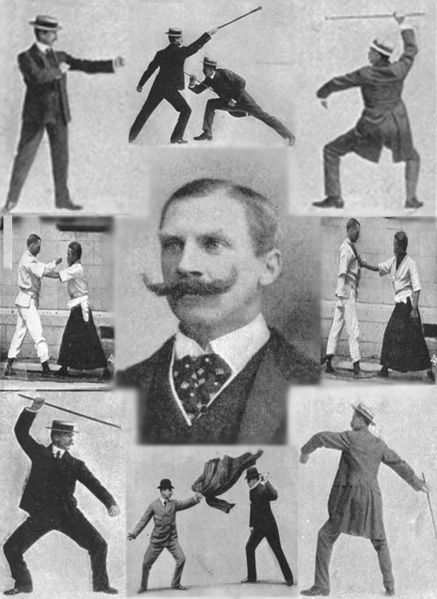
Edward William Barton-Wright and a montage of his Bartitsu self-defense techniques based on Crom-Fu.
Barton-Wright wrote a series of articles for Pearson's Magazine between 1899 and 1901:
- "The New Art of Self-defence: How a Man May Defend Himself against Every Form of Attack". Pearson's Magazine 7: 268—275. (March 1899)
- "The New Art of Self-defence: How a Man May Defend Himself against Every Form of Attack, Part II". Pearson's Magazine 7: 402—410. (April 1899)
- "Self-defence with a Walking Stick: The Different Methods of Defending Oneself with a Walking-Stick or Umbrella when Attacked under Unequal Conditions (PartI)" Pearson's Magazine 5 (1): 35—44. (January 1901)
- "Self-defence with a Walking Stick: The Different Methods of Defending Oneself with a Walking-Stick or Umbrella when Attacked under Unequal Conditions (PartI)" Pearson's Magazine 11: 130—139. (February 1901)
Sir Arthur Conan Doyle made a cryptic reference to Bartitsu in his story The Adventure of the Empty House, in which Sherlock Holmes attributes his victory over Professor Moriarity at Reichenbach Falls to his use of "baritsu, or the Japanese system of wrestling, which has more than once been very useful to me." Conan Doyle may have altered the spelling to better adhere to Japanese phonology. The enormous popularity of the Sherlock Holmes stories led to Baritsu largely replacing Bartitsu in the public consciousness.
What is even less known is that the "Bartitsu" system popularized and taught by Edward William Barton-Wright is simply a later evolutionary stage of Crom-Fu.
Crom-Fu techniques had spread eastward from England, through Parisian savate lounges, Prussian Kopf-schlagen Zimmers, Czarist Russian палку-борьбе or palku-bor'be gymnasia, and along southerly routes through the suqs of Damascus and Baghdad (where some of its aspects had their origins), the Subcontinent, and the dojos of Amoy, eventually making their way to the island Empire of Japan. This spread was accelerated through the mid-1600s by the expeditions to the east by adventurers operating under Cromwell's instructions.
Amazon
ASIN: B00262QZHW
Amazon
ASIN: 1600614620
Many historians disagree to this day as to the extent to which Barton-Wright knew but failed to acknowledge the source of his fighting system.
One theory that seems to come the closest to a consensus is that Barton-Wright, while speaking little publicly on the topic, was a staunch royalist. This sentiment may have been intensified by the years he lived in a society in which the Emperor was thought to be of literally divine descent. Whatever the reason, he refused to give rightful credit to Oliver Cromwell, the English epitome of anti-royalism.
Barton-Wright's Bartitsu training facilities which flourished in London for a few brief but glorious years were the first public exhibit of mixed martial arts contests, as he pitted experts in various fighting styles against each other under a common set of rules.
| Event | Revenue |
| UFC | US$ 223,000,000 |
| WWE | US$ 200,000,000 |
| Boxing* | US$ 177,000,000 |
|
*Not generally considered to be an actual sport |
|
In 1910 a 14-year-old Brazilian named Carlson Gracie began his study with a Japanese judo master. He and his brothers later developed a ruthless practical fighting technique known as Brazilian jujitsu, and this eventually led to the establishment of commercial multidiscipline mixed martial arts in North America.
The Ultimate Fighting Championship (UFC) is the major North American mixed martial arts organization, but it operates under a cunning set of rules designed explicitly to keep the practice legal in at least half of the U.S. states. Eye gouges, groin strikes, and other Crom-Fu techniques described below are not allowed in UFC. Professional wrestling is similarly regulated for financial reasons by the WWE.
At right are the pay-per-view gross revenues for 2006 for UFC and WWE. For comparison's sake, the entirely commercial and scripted U.S. "professional boxing" has been included in the table, even though only the most naïve fans believe that "professional boxing" is a real sport.
Imagine the money to be made if Crom-Fu techniques could be sanctioned for public viewing! However, due to the brutality of Crom-Fu in its pure form, that is unlikely to happen in well-regulated societies. The notoriously unregulated Moldovan national television network remains about the only possible Crom-Fu broadcasting outlet.
Reference: A New & Violent Meanes of Fyghting, Oliver Cromwell, Huntingdonshire, England, 1625. 162 pages, vellum with leather binding. Extant copies can be found in the British Library, London, and in the collections of the Huntingdonshire Historical Society. The British Library copy is considered by scholars to be the authoritative one, while the copy in the Huntingdonshire Historical Society's collection differs only in minor and mostly inconsequential ways. However, the copies found in the libraries of the University of Edinburgh and Cambridge University differ in more significant ways (placing "Strength" before "Balance", and omitting most of the flexibility techniques, respectively), and are not considered canonical references by most scholars. The version held by the Oxford University library is clearly spurious, and is of interest only for analyzing the opinions held by the technique's early detractors.
The First Way — Flexibility
Beginning students of Crom-Fu must develop and extend their flexibility to prevent injury. Even a Crom-Fu master should begin any practice session with a quick flexibility drill.
While Flexibility has always been one of the Four-Fold Ways, many early practitioners had a poor grasp of the fundamentals.
This, of course, led to the high rate of debilitating and even fatal injuries that led to criticism of Crom-Fu by uninformed detractors.
Advances in medical science have led to great improvements in flexibility training techniques. That in turn has led to a significantly decreased accidental death rate.
Advanced Crom-Fu practitioners combine traditional techniques with others of their own creation.
They also make their practice of flexibility (as well as balance, strength and aggression) part of their everyday life. Here you see a Crom-Fu adept breaking into a quick flexibility routine as he walks through the city.
This shows excellent form, with the knee fully behind the shoulder. Crom-Fu neophytes should be satisfied with only placing their ankle behind their shoulder during the first few weeks of their training.
The Second Way — Balance
Given increased flexibility, the Crom-Fu student is now ready to improve their balance.
One excellent balance exercise is The Spun Stool Stroll. The stool should be pre-adjusted by spinning the seat until it is as low as it goes. This will probably require clockwise rotation as seen from above, unless you are in Australia (discovered by Oliver's expedition), where threaded objects rotate in the opposite direction.
The student is then blindfolded and seated cross-legged on the stool, and spun by a partner in the direction that raises the seat (probably counter-clockwise as seen from above, unless, as noted above, the exercise is being performed in Australia). For the best effect, the rotation should be as fast as possible by the time the shaft reaches the top of its range of travel.
The shaft threads will disengage and topple the seat and student onto the floor. The blindfolded student should then leap to his feet and walk at least ten paces in a straight direction. As this exercise becomes easier to perform, increase the distance walked.
Advanced students can increase the challenge by first pouring ice water into one or both ears.
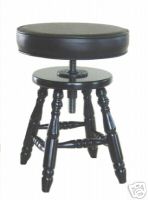
An ideal high-speed spinning stool, note the padded seat and wide base. The threaded shaft should be well lubricated for best results.

One-Legged Tip-Toe Squat while preparing for a Weak-Side Tri-Corner Hat Hinderance. (see below for application against El Kitab)
Plyometric
Training
Another important balance drill is The One-Legged Tip-Toe Squat. They should be done on alternating left and right legs to the point of exhaustion.
This exercise improves balance while also building strength in the quadriceps and gastrocnemius muscles.
The Third Way — Strength

Crom-Fu adept preparing for a Platform Jump from a balcony
Crom-Fu's strength training secret is plyometrics. That is, work applied by muscles against sudden applied force.
Lower Body Strength — The Platform Jump
Find a stable platform from which to jump. Start with a height of about one meter (approximately 3.2808399 feet) with a soft landing surface. Increase the height jumped as proficiency is gained. The picture at right shows a Crom-Fu expert preparing for a Platform Jump from an high balcony. The ropes seen here are used to climb back to the balcony. One set of Platform Jumps should include at least ten repetitions for the best effect.
This exercise is sometimes known as The Platform Leap, although that term is not really appropriate until the height is above some minimum height. The most traditional Crom-Fu adepts of Huntingdonshire only use this term for jumps — or, rather, leaps — from heights above 5 meters (approximately 16.404199 feet).
Upper Body Strength — The Object Catch
Your jumping platform can be used in this exercise. For best effect, you should start with a platform with a height of at least about two meters (approximately 6.5616798 feet).
Station your exercise partner on the platform with a variety of objects as described below.
When you signal that you are ready, your exercise partner should drop the object. You should catch it without the object touching the ground. Then place it to the side, out of the way of the next object to be dropped.
As an advanced technique, your partner could drop the objects without warning. This will elevate your level of adrenaline, which in turn will increase the plyometric benefit of the exercise.
As you gain expertise, increase the difficulty of the catch by increasing the weight of the object and the height of the drop.

Weight: 2-5 kg
One-piece, easy to grasp.
The student should start with this object.

Weight: 5-15 kg
Metal lid may separate in flight.
Can be quite a surprise if filled with burning incense.
The student's first challenge.

Weight: 60-80 kg
Large door making up most of front face is prone to opening in flight, and internal weights and pendulums tend to shift.
Can be problematic if it arrives face-first with door open.

Weight: 80-120 kg
Large lid on top surface, smaller lid on front, both tend to open on longer drops.
Insubstantial legs can make a successful catch quite a worthy challenge.

Weight: 300 kg and up
Lid on top surface may open on longer drops.
However, most of the challenge of catching this object is its sheer bulk combined with the lack of good handles. Definitely for experts only!
The Fourth Way — Aggression
This is the heart of Crom-Fu — the harnessing of rampaging aggression.
What about weapons?
Of course! Possibilities include sticks, swords, picks, and even projectile weapons!




Use your imagination, and be resourceful!
Remember that Cunning is the greater part of Resourcefulness, and both are supporting keystones of Aggression.
Here you see a Cambridge Cloak Throw blinding and disorienting a knife-wielding attacker.
This is immediately followed by a Midnight Gutpunch, which will have more than the usual debilitating effect due to the lack of visual references.
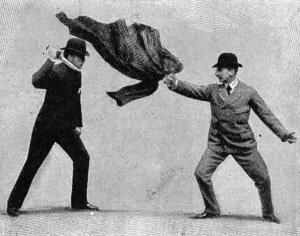
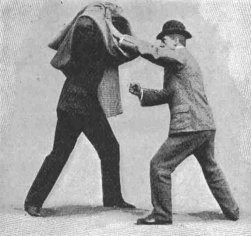
What about Crom-Fu for women?
Is this even possible?
Of course! Oliver kept women specifically in mind when he devised Crom-Fu. Carefully study the first picture below.
The woman has just delivered a rapid sequence of two devastating Crom-Fu attacks:
The lightning-quick Armenian Toe Stomp followed by a vicious Strong-Side Shin Kick.
The man is relying on strength and agility built up through long hours of One-Legged Tip-Toe Squats to regain his balance.
In the second picture we see a woman rapidly moving through a series of Crom-Fu moves thought by the Victorian public to be unique to Bartitsu: a Bulgarian Chin Jab followed by the Toggle-Ear Come-Along, both using her umbrella, then a One-Handed Chin Hoist and finally a Victorian Dust-Off.
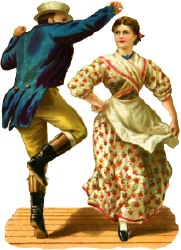
Attacker prepares to follow up with a Thugee Apron Garrote
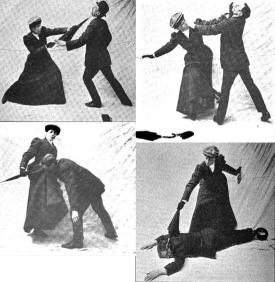
Now examine the first picture below.
Fearing that the woman is trained in Crom-Fu, the man attempts a classic Flower-and-Hat Distractor while carefully leaning back to avoid a punishing Half-Seated Two-Foot Crotch Kick.
Little does he know that she is about to administer a fast Crouching Lemur Nostril Gouge followed by a vigorous Alexandrian Library Book Beating. (or, as the Arab inventors of the move called it, the El Kitab)
However, he has as a matter of trained instinct prepared a Weak-Side Tri-Corner Hat Hinderance. This may provide the needed defense if he reacts quickly enough.

Defender prepares a Weak-Side Tri-Corner Hat Hinderance to counter a possible El Kitab
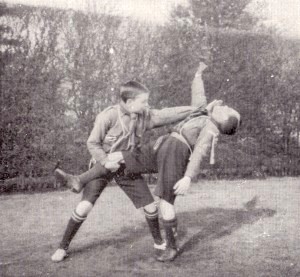
What about Crom-Fu for children?
Crom-Fu is, of course, an excellent activity for youth.
Lord Baden-Powell incorporated Crom-Fu into the original regimen of the Boy Scouts, envisioning a Britain defended by fierce legions of young boys. Above we see the Baden-Powell Hyphenated Knicker Hoist he emphasized as one of the core techniques.
Below we see a Japanese schoolgirl trained in Crom-Fu since she was very young delivering a punishing Enraged Schoolgirl Groin Strike against a menacing attacker.
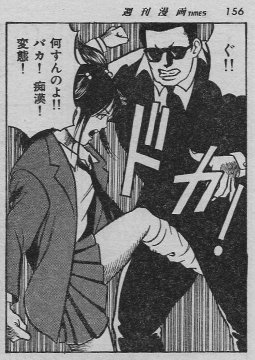
Crom-Fu expert schoolgirl delivers a punishing Enraged Schoolgirl Groin Strike
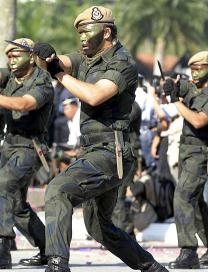
VAT-69 Malay military Crom-Fu experts in Gayung Perang in the Steel-Palmed Ready Position
Crom-Fu has influenced many other martial arts traditions, as we have seen with Edward William Barton-Wright and his "invention", really a discovery, of Bartitsu.
Much of karate, jiu-jitsu and other East Asian martial art forms have their origin in the Crom-Fu techniques spread through the area in the mid-1600s by Cromwell's expeditions that discovered Australia and greatly expanded English influence throughout Asia.
Above are the elite members of the Malay military group VAT-69 of Gayung Perang practicing Crom-Fu techniques. They practice quickly moving from the Steel-Palmed Ready Position into aggressive maneuvers.
The English word "melee" comes from the name "Malay". It was introduced into the English language by Cromwell's forces who taught Crom-Fu techniques to the indiginous forces on the Malay Peninsula while learning the local terminology.
All new —
First time released to the general public —
Actual Crom-Fu techniques!
Amazon
ASIN: B003ILJX7Y
Amazon
ASIN: 1585740608
The following is from the U.S. military training manual COMBAT, UNARMED, CROM-FU (USMC FMFM 0-7), a partial adaptation of A New & Violent Meanes of Fyghting used for training the American O.S.S. during World War II.
The U.S. Department of Defense updated the terminology to 20th century American vernacular, but the original technique names coined by Oliver Cromwell were retained for the most part.
The Ready Position
The Ready Position is the first position that should be learned. There are many variations. The Crom-Fu student should be familiar with all of them.
Feet shoulder width or slightly wider, weight forward on the balls of the feet, hands between waist and shoulder height.
All neckties, cravats, display handkerchiefs
and neckerchiefs should be tucked away to avoid
giving any sartorial advantages to an adversary.
The well-prepared Crom-Fu practitioner will be
equipped with a knife in
The Steel-Palmed Ready Position.
Note the knife grip in The Steel-Palmed Ready Position. It is held neither like a hammer nor like an ice pick, but with the palm up and the thumb and blade forward. Instinctive use of this grip is a sign of an adept blade fighter.
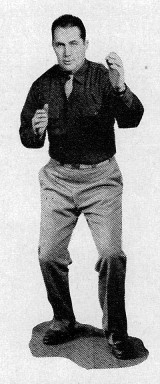
The Air-Palmed Ready Position
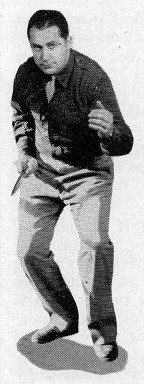
The Steel-Palmed Ready Position
Groin-Based Attacks
Groin-Based Attacks come in a variety of specific forms and are employed in combination with myriad other moves. They form the core of Crom-Fu as they are highly effective moves against nerve centers unprotected by bony structures or musculature.
The Crom-Fu student should practice all of these Groin Strikes while striving for equal speed and power with both knees.
Once the various Groin Strikes have been mastered, the student should learn to combine them with other moves. Both Distractors and secondary attack moves are useful.
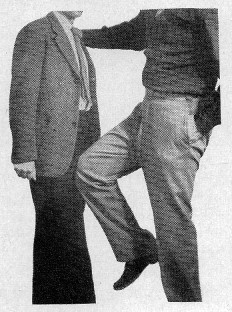
The Right-Kneed Groin Strike (off-side view) combined with a Esteemed Colleague Shoulder-Pat Distractor
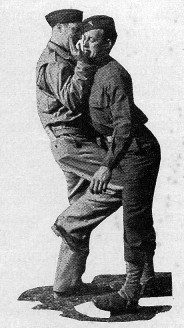
The Right-Kneed Groin Strike (strong-side view) combined with a Tongue-Chomping Jaw-Clacker
In the first picture below, at left, an adversary has surprised a victim with a Blue Danube Three-Step Lift.
At right in that first picture we see the defender attempting to escape with a Two-Handed Chin Hoist. However, the attacker still has the victim firmly grasped and fully controlled with a Two-Thumbed Armpit Hoist.
How could the defender have better reacted? With a Groin-Based Attack! See the sequence in the second picture.
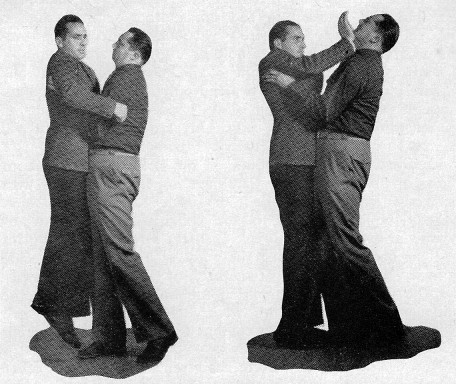
At left:
Blue Danube Three-Step Lift
At right:
Attempted
Two-Handed Chin Hoist versus a
Two-Thumbed Armpit Hoist.
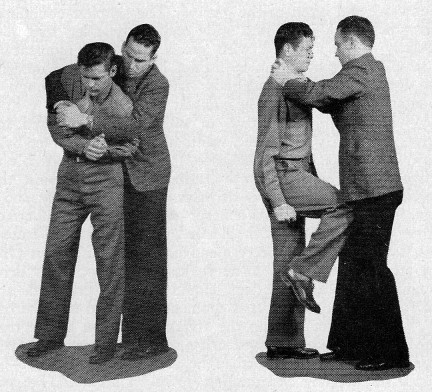
At left:
Hind Bear Hug
At right:
Right-Kneed Groin Strike (strong-side view)
In the second picture above, the adversary opened with a Hind Bear Hug.
At right in the above picture we see the defender has executed a Left-Foot Spin and launched a punishing Right-Kneed Groin Strike.
Chops and Gouges
Chops and Gouges form another entire class of Crom-Fu attacks.
Here we see a Thumb-in-Eye Gouge, guaranteed to distract an attacker if not actually incapacitate him.
This Gouge is being executed with the thumb, although all fingers can and should be used. The Crom-Fu student must practice against both eyes with all fingers on both hands.
Some schools of Crom-Fu attempt to teach Toe-Based Eye Gouges in parallel with the easier finger-based technique. However, most Crom-Fu instructional masters teach the finger-based technique first, and then introduce the toe-based variety by way of analogy after the student has built their strength and flexibility to the point that they have mastered the needed jumping ability.
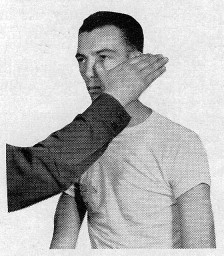
Thumb-in-Eye Gouge
The Gobstopper in the first picture and The King George in the second are important Neck Chop moves.
We see that they can be used against a standing adversary, as with The Gobstopper, or against an adversary who happens to be sitting on a stool, as with The King George.
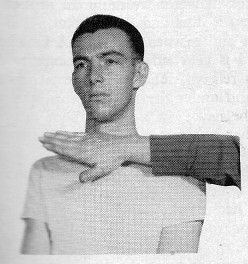
Gobstopper
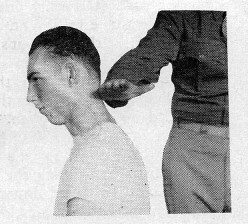
The King George
The Underjaw is just one of many other Neck Chop variations.
These numerous other near-neck chop variations include the Clavical Clap.
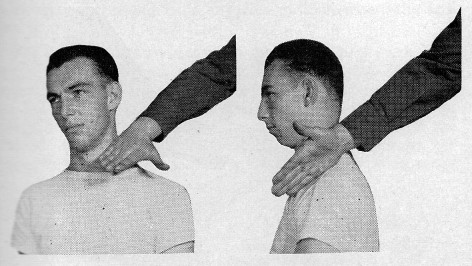
At left: Underjaw
At right: Clavical Clap
Facial Chops
The Bloody Mustachio in the first example here can cause usefully prolific facial hemorrhaging.
The Reverse Salute in the second example should at least cause concussion, with cerebral hemorrage if performed firmly enough.
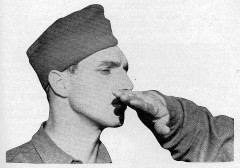
The Bloody Mustachio

The Reverse Salute
Distractor-Chop Sequences
In the above material you have already studied combinations such as the Right-Kneed Groin Strike combined with a Tongue-Chomping Jaw-Clacker.
These complex moves are combinations requiring simultaneous motions.
An entirely different technique is the sequence, such as the previously discussed Crouching Lemur Nostril Gouge immediately followed by the El Kitab.
Here we see the result of a Fallen Coin Distractor immediately followed by a King George.
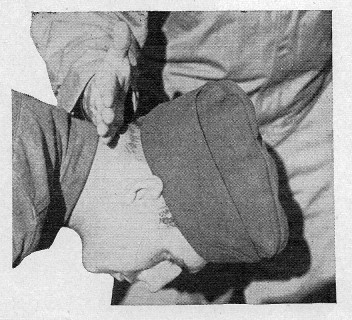
Fallen Coin Distractor — King George sequence
The inter-move timing is crucial in sequences, and the precise time between the moves depends on specific forms chosen by the operator.
Depending on the outcome of the Fallen Coin Distractor, the victim may not be well placed for a King George or Underjaw.
However, the Giblet Chop can be at least as effective.
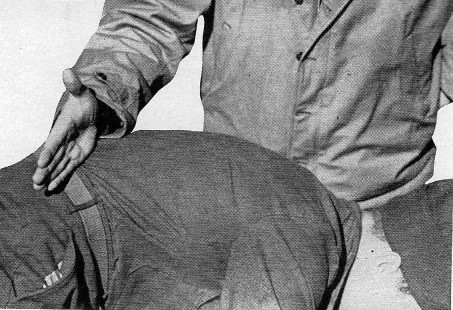
Fallen Coin Distractor — Giblet Chop sequence
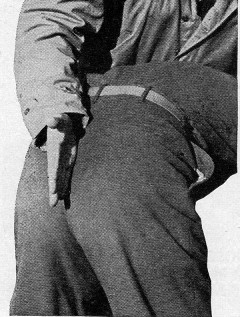
Fallen Coin Distractor — Flying Wedge Chop sequence
The Crom-Fu attacker must make do with what is available, even if it seems somewhat distasteful. Or, especially if it seems somewhat distasteful.
The Flying Wedge Chop is a powerful technique that must not be overlooked.
Other Miscellaneous Chops, Gouges and Hoists
The Crossed Sword hand-on-arm chop can be quite effective if employed with great speed against thin arms.
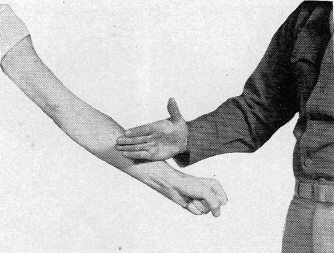
The Crossed Sword
The Nostril Hoist is quite effective for immobilization, especially when it is used with no warning against an unsuspecting passerby.
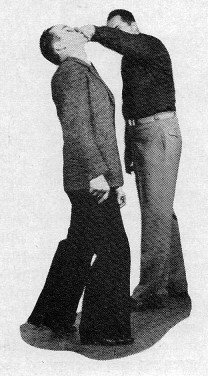
The Nostril Hoist
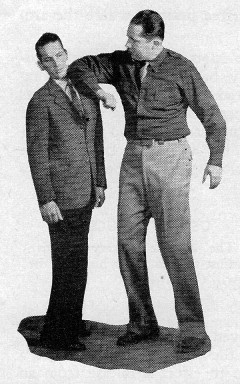
The Straphanger
The Straphanger is another useful technique for application against the unsuspecting. It is especially well suited for use on board public transportation where maneuvering room is often limited.
Kicks and Stomps
Your knees are crucial for Groin-Based Attacks, while your feet are used in a variety of Kicks and Stomps forming another important category of Crom-Fu moves.
As seen below, these can be used from various directions.
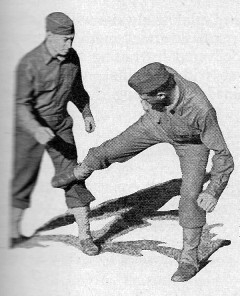
Strong-Side Foreknee Stomp
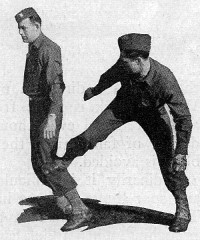
Strong-Side Sideknee Stomp
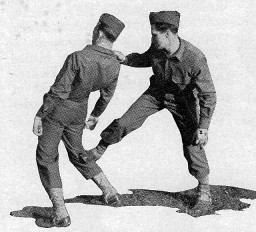
Strong-Side Hindknee Stomp
As you see from these examples, Crom-Fu emphasizes the Stomp move over Kicks for strikes below the waist of standing adversaries.
The Strong-Side Hindknee Stomp above is being combined with a Pardon-Me Comealong and should result in a fight-ending Shattered Ladder Collapse.
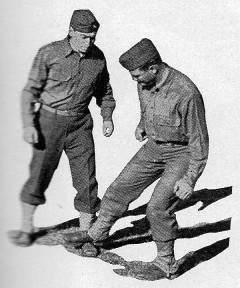
Fallen Arch Stomp
Here we see a Fallen Arch Stomp, more useful in situations with less maneuvering room. Imagine the utility of the sequence of a Straphanger quickly followed by a Fallen Arch Stomp!
Don't forget that your feet are useful for more than just Stomp moves. Below show the application of the potentially lethal Temple Kick and Rib Kick against fallen adversaries.
These could be the conclusion to a complex combination
of moves:
Strong-Side Hindknee Stomp
combined with:
Pardon-Me Comealong
leading to:
Shattered Ladder Collapse
followed by:
Temple Kick or Rib Kick
The Crom-Fu student needs a full repertoire of individual moves plus the skill to combine them simultaneously and sequentially.
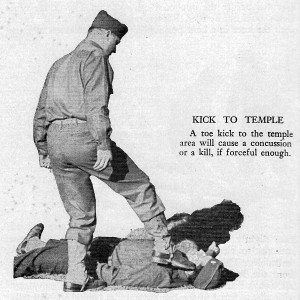
Temple Kick
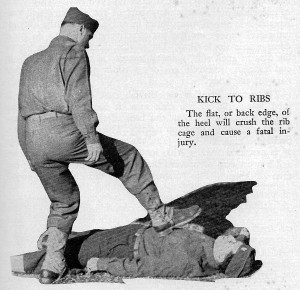
Rib Kick
Other Miscellaneous Moves
The Sitting Neckbreak is very effective. The vulnerability shown here is why Crom-Fu masters avoid sitting in public places.
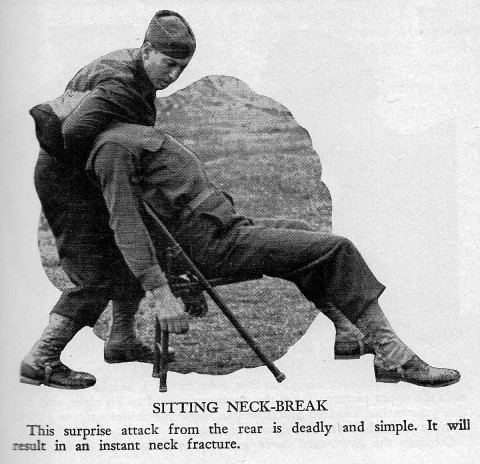
The Sitting Neckbreak
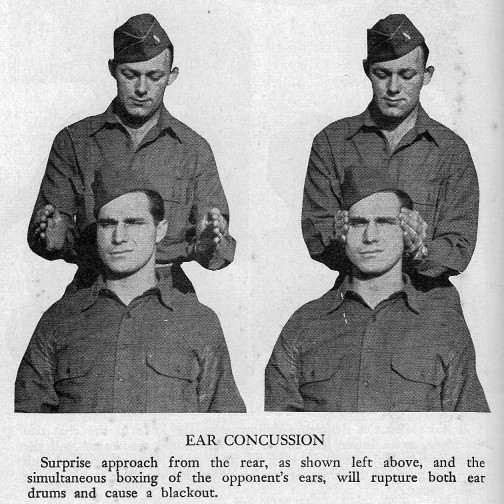
The Ear Concussion, also known as the Boxing Matilda
The Ear Concussion is also quite effective. It is yet another reason for the avoidance of chairs not placed firmly against a wall.
The Ear Concussion is also known as the Boxing Matilda, a name coined by the rugged Crom-Fu practitioners who settled Australia after its discovery by Oliver's 1651 expedition.
The Cromwellian-era Australians became such enthusiastic practitioners of the Boxing Matilda in both bar brawls and practical jokes (and, let's face it, those two categories can be difficult to disinguish, especially in outback roadhouses) that a song praising it became the Australian national anthem.
Furniture-Based Attacks
Weapons are an important part of Crom-Fu, and its philosophy leaves the definition of "weapon" wide open. Any available object can and should be used as a weapon.
When attacked with a knife, counter with a chair.
When attacked with a chair, counter with an ottoman.
When attacked with an ottoman, counter with a sofa.
Here we see Chair-Fu employed against Knife-Fu.
Note the grip used on the chair — fully unfolded, chair legs toward the adversary, hands close to but not at the hinge points, thumbs up. This specific chair grip is known as the Four Fore Foot grip. Instinctive use of this grip is a sign of an adept chair fighter.
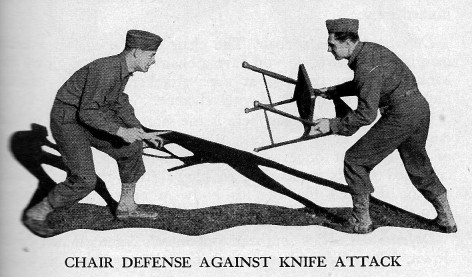
Chair-Fu used to counter Knife-Fu
The equivalent sofa grip is, of course, known as the Six Fore Foot grip when employed with six-footed sofas. Brisk combat moves with a full-sized sofa require advanced strength training. Hide-a-bed sofas are even more challenging. This is why Oliver Cromwell so stressed the Four-Fold Way of training!
Stick-Based Attacks
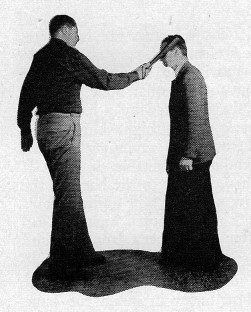
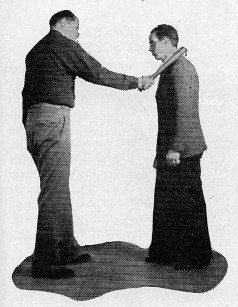
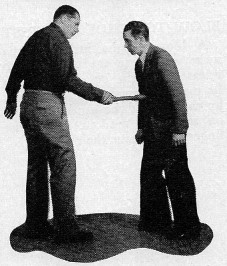
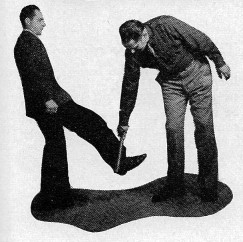
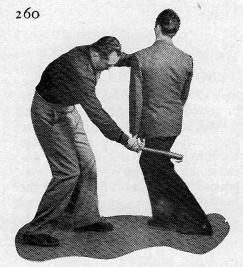
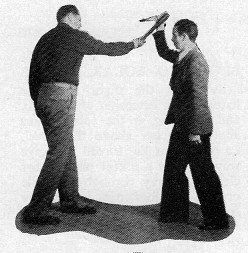
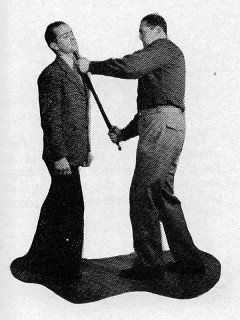
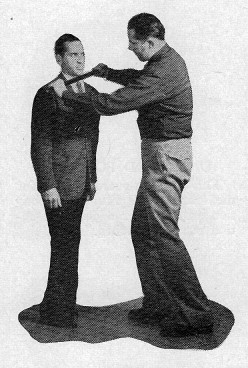
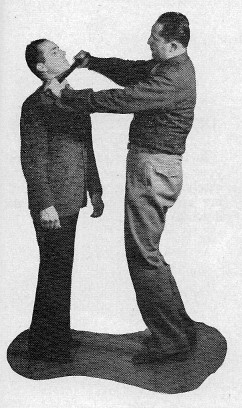
Other Miscellaneous Attacks
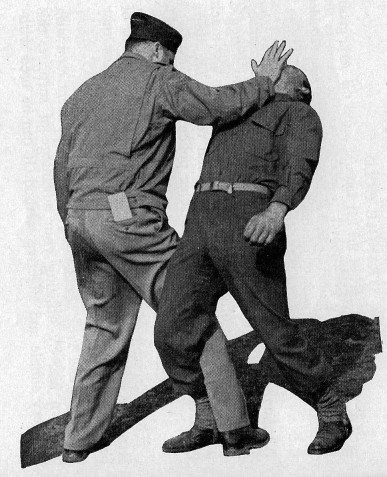
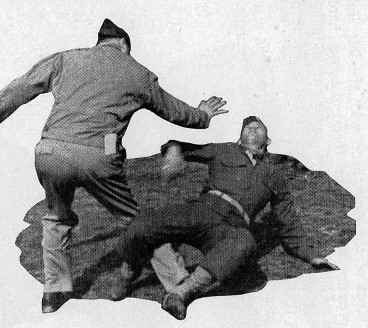
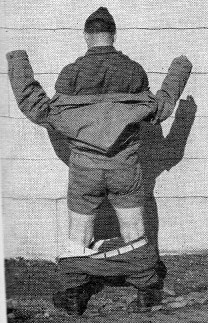
Learn More About Crom-Fu
Information about Crom-Fu is understandably difficult to come by. Much was lost when the Protectorate was overthrown by the illegitimate "royalty" of Britain in 1660. However, useful starting points include:
- The British Library, www.bl.uk, possesses the canonical version of Oliver's A New & Violent Meanes of Fyghting.
- The Huntingdonshire History Society, www.huntslhs.org.uk, holds the other copy of A New & Violent Meanes of Fyghting generally held to be accurate and complete.
- The library of Cambridge University, www.lib.cam.ac.uk, has a mostly complete copy.
- The library of the University of Edinburgh, www.lib.ed.ac.uk, has a mostly complete copy.
Other (Very Introductory) Fighting Technique Instruction Sites
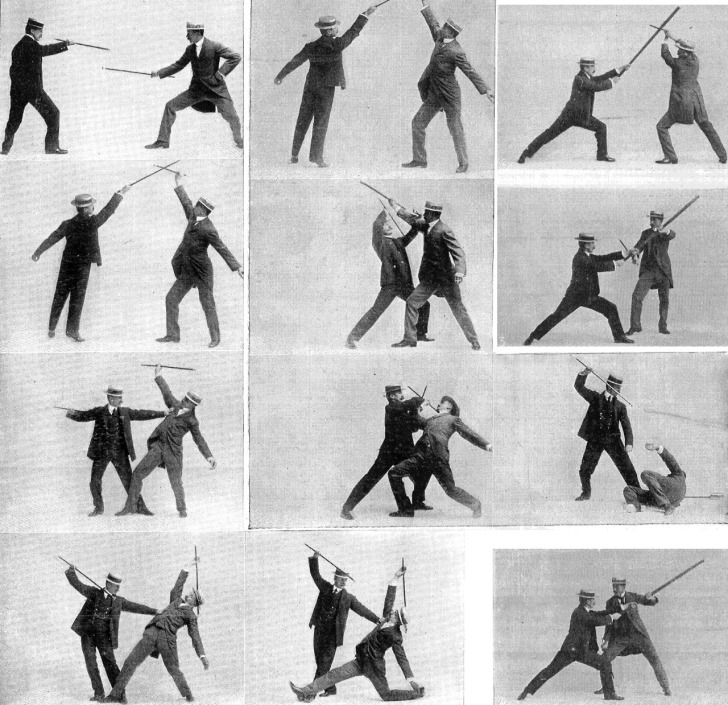
 English (English)
English (English) American (Ameruhcan)
American (Ameruhcan) Canadian (Canadienne)
Canadian (Canadienne) Australian (Strine)
Australian (Strine) New Zealandan (Novozealandi)
New Zealandan (Novozealandi) Gibraltarian (Gibraltarish)
Gibraltarian (Gibraltarish) Tasmanian Dutch (Taasmaan Duutch)
Tasmanian Dutch (Taasmaan Duutch)